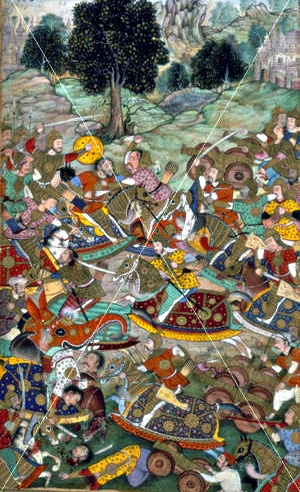
Babur’s army in battle against the army of Rana Sanga at Kanvaha (Kanusa) in which bombards and field guns were used.
Also known as “Khanua.” A clash in north India between Babur, who founded the Mughal Empire in Delhi the year before, and a coalition army of seven Rajput rulers. The Rajputs were nominally generaled by one of their greatest warrior heroes, Maharana Sangram Singhi, better known as Rana Sanga. His army enjoyed a huge numerical advantage, deploying 80,000 men and some 500 war elephants. Moreover, Babur’s army of just 20,000 Afghans, Mongols, and Turks was virtually surrounded, in unfamiliar territory, unused to the oppressive Indian heat, and most of its men wanted to go home after more than a year of campaigning in India. Only the promise of more plunder of India’s wealth kept the men from returning to cooler homes around Kabul. At Khanwa, as also happened to the army of the Delhi Sultanate at Panipat (1526), the marked superiority in musketry and artillery of Babur’s men told the tale against superior Indian numbers. Babur also displayed exceptional leadership. When the clash came the Rajputs overwhelmed by sheer numbers a Mongol van of just 1,500 men. The advantage gained by Rana Sanga was dissipated, however, by dissent among his confederate generals over how to proceed and who would command. In the interim the Afghans entrenched, forming a strong defensive line and securing their position as they had at Panipat by lashing together wagons to make a field fortification (tabor). They left strategic gaps among the wagons through which artillery could fire and their cavalry sally forth. Rajput warriors repeatedly hurled themselves against the center right of Babur’s line, making furious charges and fighting hand-to-hand over several hours. Sanga, who was wounded several times, then sent his elephant corps forward. Babur’s cannon killed a number of the beasts and panicked and stampeded the rest. This swung the battle for the Afghans. Seeing this, part of Sanga’s army crossed over to join Babur. After his victory Babur decamped for Agra, 60 miles away.
Babur (1483-1530).
Ne’ Zahir ud-Din Muhammad. King of Kabul; founder of the Mughal Empire. Babur was descended from Timur and Chinggis Khan by blood, and in his predatory warlordism. However, in the Uzbeks he faced a formidable enemy he was not able to overcome: they resisted his repeated attempts to recapture Samarkand and other, formerly Timurid cities in Central Asia. This forced Babur into Afghanistan, where he took Kabul in 1504. From there he continued to battle the Uzbeks, failing again to take Samarkand in 1512. Babur next looked to India as a wealthy yet vulnerable land ripe for raiding, to enrich his dynasty. In 1519 he began raiding in force into north India. In 1526 he met and defeated a much larger Indian army at Panipat (1526), killed the sultan, took Agra and Delhi, and toppled the Delhi Sultanate. The next year, at Khanwa, he won a key victory over the Rajputs. This laid open all of northern India for invasion rather than mere raiding. His grandson, Akbar, completed the Mughal conquest of north India.
Mughal Army.
The great Muslim empire in India maintained the second largest standing army in the world in this era, in terms of sheer numbers of men and beasts (horses, bullocks, and camels). Tens of thousands of permanent troops were maintained, along with an elephant corps. From the 15th century the Mughals attached an artillery train. The bulk of the army was poorly trained infantry, so that its real striking power remained heavy cavalry well into the 17th century.
Rana Sangha (r. 1509-1527).
Ne’ Maharana Sangram Singh. Rajput king of Mewar. His expansionist wars against neighboring states gained him recognition by most Rajputs, but his consolidation of power was interrupted by the invasion of north India by Babur. After Babur overthrew the Delhi Sultanate in 1526 the Rajputs united under Rana Sanga and fielded a confederate army. At Khanwa in 1527 superior Moghul artillery and musketry firepower defeated the much larger but politically divided Rajput army.
Suggested Reading: Babur, The Babur-nama in English, Susannah Beveridge, trans. (1921); Bamber Gascoigne, The Great Moghuls (1971). Suggested Reading: W. Irvine, The Army of the Indian Mughals (1903).